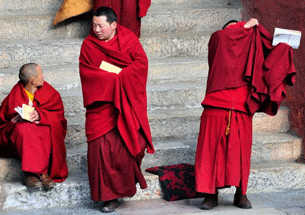Tibetan self-immolations continue in northwestern Gansu
ANANTH KRISHNAN, The Hindu:A Tibetan farmer set himself on fire outside the Labrang monastery, one of Tibetan Buddhism’s most important sites, in the northwestern Chinese province of Gansu on Monday morning, according to monks in India and overseas groups.
Monday’s self-immolation followed another protest in Gansu on Saturday, when a man set himself on fire near the Bora monastery.
Tibetan monks based in India said a farmer named Dundrup (65) carried out the self-immolation on Monday morning near the walls of the famous Labrang monastery, adding that initial reports out of Labrang, known as Xiahe in Chinese, said he had died following the protest. The monastery is a key site of pilgrimage for the Gelugpa or Yellow Hat sect, for whose members the Dalai Lama is the most important figure.
Monks in India were sent photographs showing dozens of monks gathered outside Labrang and the body of a man engulfed in flames lying near the walls of a temple. Dundrup, the monks said, had lived in a village called Ngagpa, located next to the monastery, for 15 years.
On Saturday, another self-immolation was reported in Gansu, near the Bora monastery which is located a few hours’ drive from Labrang. Overseas groups said a 27-year-old Tibetan named Lhamo Kyab carried out the protest near the monastery, which was the site of protests in April when State media reported 60 monks carried out a protest march.
More than 56 Tibetans have now set themselves on fire to protest Chinese policies since the series of self-immolations began in the Sichuan town of Aba in 2009. While the Aba prefecture has been the site
of most protests, the immolations have spread to other Tibetan areas in recent months.
Tibetan areas in Gansu, which lie across the provincial border to the north of Aba, have witnessed several protests since March this year. Fewer incidents have been reported in Tibetan areas in Qinghai, home to the important Rebkong monastery where two people set themselves on fire in March. The Tibet Autonomous Region (TAR) had also not seen any immolations until May, when two monks from Gansu and Sichuan carried out protests in Lhasa.
In Gansu, the protests have appeared to spread beyond monastery walls. Dundrup, who reportedly died on Monday, was a farmer, while in March, Tsering Kyi, a student in the town of Maqu, died after setting herself on fire. While Tsering Kyi’s protest and the march by monks in Bora in April were both confirmed by State media, this week’s self-immolations have, as yet, not been officially confirmed.
In recent months, Chinese authorities have increased security deployments in Tibetan areas in Sichuan and Gansu, which are now entirely off-limits for journalists. This correspondent was stopped outside Labrang, the site of Monday’s protest, during a visit in April, when the town was sealed off by checkpoints of police forces.
Local security officials said then that Tibetan areas were out of bounds because of the “sensitive” situation.

Comments
Post a Comment